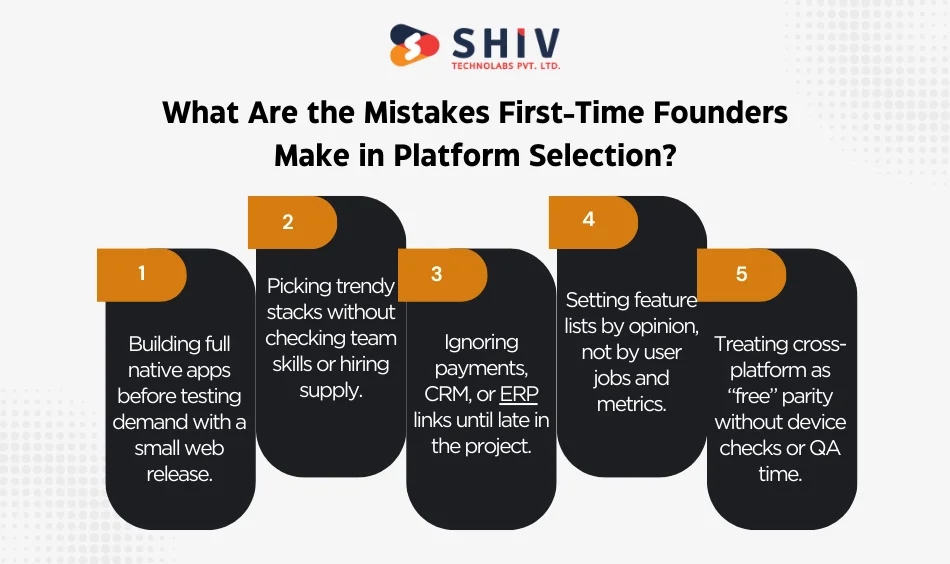Table of Contents
The platform you choose first affects launch speed, budget, and how customers experience your product. Many founders work with a startup development company to decide between web, mobile, cross-platform, or a SaaS path. That choice sets expectations for user trust, release pace, and ongoing maintenance.
A platform is simply the surface customers interact with first. Web works well for broad reach and quick trials in a browser, without downloads or store approval. Mobile supports longer sessions, push alerts, and offline access. Cross-platform targets iOS and Android together, while SaaS provides scalable delivery through the cloud.
The decision should reflect audience habits, spending, and the pressure on your roadmap in the first quarter. Pick a path that matches where users are, fits your budget, and allows growth without heavy rework. Clear criteria help teams build a lean start, test demand early, and avoid costly detours.
The startup technology stack should also match the audience, budget, and timeline. A strong first release focuses on one core outcome with a shortlist of measurable behaviors to track. Keep scope tight, prioritize must-have workflows, and delay nice-to-have ideas until real usage confirms demand.
If you need expert support, our team plan, build, and backs the first launch with reliable startup development services.
Quick checks before choosing
- Audience: web for broad reach; mobile for deeper sessions; cross-platform covers both stores.
- Budget: web is usually lower; native builds cost more across iOS and Android.
- Timeline: web ships faster; app stores add review time.
- Revenue: SaaS supports subscriptions from day one.
Why Does Platform Choice Matter for Startups?
Platform choice sets the first impression, habit patterns, and how customers return after a first trial. A web start reduces friction with shareable links and supports rapid updates through continuous delivery. A mobile start places your icon on the home screen, adds push alerts, and enables offline sessions.
Separate native builds create two codebases, extra QA cycles, and store review timing to plan around. Cross-platform reduces parallel effort by sharing most logic and UI across iOS and Android stores. A SaaS path introduces subscriptions, roles, and integrations, which increase scope but strengthen revenue mechanics.
Scalability rests on clear boundaries, tested modules, and a data model that supports growth later. Keep the startup technology stack explained for non-technical teammates, so decisions map to cost, speed, and risk. Match audience behavior, budget, and learning goals to the best platform for the startup outcomes you want.
A smart starting point also improves fundraising conversations and partner trust. Clear reasoning shows discipline and makes future expansion smoother.
Impact areas
- User experience: trial friction, session depth, offline access, and device features.
- Cost pattern: skills, QA effort, parallel builds, and store rules.
- Release pace: web pushes anytime; mobile follows version cycles.
- Growth path: architecture choices affect scale and maintenance.
What Factors Should Founders Consider Before Choosing a Platform?

Picking a platform works best when you collect a few hard facts up front. Map your audience habits, budget range, and launch deadline before discussing frameworks. Add one page that lists must-have features for day one, and keep everything else in a parking lot.
Who Is Your Target Audience?
Start with device habits, not opinions. If prospects arrive through search, email, or long-form content, a web start usually fits. If sessions happen during commutes, workouts, or field work, a mobile start often wins with push alerts and offline access.
List the top three user jobs to be done, then assign where they happen. Desktop supports research, forms, and back-office tasks that need larger screens. Phones shine for quick checks, photo capture, location needs, and simple repeat actions during a busy day.
How Much Budget Do You Have for Development?
Budget shapes scope, team model, and go-to-market speed. Set a clear ceiling, then align features to that ceiling with a small buffer. When comparing quotes, ask for the “must-have only” version first and mention the cost of startup app development as a key decision line.
Approximate MVP build ranges (scope and team rates vary):
| Platform | Typical MVP Range (USD) | Notes |
|---|---|---|
| Web app | $15k–$60k | Fast releases, broad reach, strong for trials |
| Mobile app (one OS) | $30k–$120k | Deeper engagement, store reviews add time |
| Cross-platform app | $35k–$90k | Shared codebase, covers iOS and Android |
| SaaS platform | $40k–$150k | Subscriptions, roles, and integrations add scope |
Use these bands as planning signals, not hard quotes. Complexity, design polish, data flows, and integrations can move numbers quickly. Ask vendors to split pricing by milestones, so you keep control as learning arrives.
Do You Need Faster Time to Market?
Short timelines favor a small web MVP or a focused cross-platform build. Treat startup MVP platform choice as a speed tool: ship a narrow slice, measure engagement, and cut anything that delays learning. Keep release notes weekly, and stack small wins before large bets.
When a deadline is fixed by an event or season, trim features to match it. Ship a public preview with basic flows and a clear feedback path. Add non-critical features in the following two sprints after users confirm interest.
Can the Platform Scale With Your Business Growth?
Think ahead about auth, roles, billing, and data volume. Pick guardrails that keep modules tidy, tests predictable, and errors visible. Keep your startup technology stack explained for non-technical teammates, so choices map to real risks and costs.
Ask two questions for scale: Do we add more users, or heavier data per user? Do we need more platforms next quarter, or deeper features on one platform first? Answers here decide database choices, service boundaries, and how much refactoring you invite later.
What Are the Common Platform Options for Startups?
Should You Start With a Web App?
A web start suits ideas that rely on search traffic, shareable links, and quick trials in any browser. Teams move fast with frequent releases, simple onboarding, and no app store gatekeepers blocking early experiments. For early discovery and signups, a web path often beats a mobile-first plan.
Keep tradeoffs in view when comparing a web app vs a mobile app for startups. Web helps with reach and speed, but push alerts, device sensors, and deep offline use favor native apps. If your core value lives in quick validation and broad access, the web path makes a strong opening move.
When Does a Mobile App Make More Sense?
Choose mobile first when habits depend on repeat sessions, notifications, camera input, or location features. A mobile icon on the home screen invites regular use, while offline access supports moments with poor connectivity. This path works well for fitness, finance, communities, and tools used on the go.
Budget and timelines differ, so weigh mobile vs web app cost with scope and audience in mind. Native builds add store reviews, two codebases, and extra QA if you cover iOS and Android. When loyalty and device features drive outcomes, strong engagement can justify the added effort.
Is Cross-Platform Development a Smart Choice?
Pick cross-platform when you want to reach iOS and Android with one primary codebase and shared logic. This route often reduces duplicated work, keeps features aligned across stores, and supports faster cycles after launch. Product teams get a consistent UI layer with access to many device capabilities through mature libraries.
For many early-stage ideas, cross-platform app development for startups balances speed, coverage, and cost control. You still plan for device quirks and performance checks, but most screens and flows ship together. This option fits MVPs, marketplaces, and content tools where parity across platforms matters from day one.
Why Do Many Startups Choose SaaS Platforms?
Choose SaaS when your model centers on subscriptions, roles, billing, and admin workflows in a browser. Customers join through simple links, teams invite colleagues, and plans upgrade through clear pricing pages. Trials, renewals, and invoices all live inside the product, which supports predictable revenue mechanics.
A SaaS platform for startups also offers strong integration paths to payments, analytics, and CRM tools. Scope increases with account management, permissions, and audit needs, so plan milestones that add value in steps. If recurring revenue and team usage define success, SaaS sets a clean path from trial to paid growth.
Practical tip: If your audience discovers products through search and content, start on the web, then add mobile. If your value depends on daily habits or device features, start on mobile, then add the web. When both stores matter and the budget is tight, a cross-platform MVP delivers a wide reach with fewer moving parts.
What Are the Mistakes First-Time Founders Make in Platform Selection?

Early teams often pick a platform on hype, not user behavior or budget facts. That habit creates bloated scopes, slow cycles, and code that becomes hard to maintain as needs grow.
5 mistakes to avoid in platform choice
- Building full native apps before testing demand with a small web release.
- Picking trendy stacks without checking team skills or hiring supply.
- Ignoring payments, CRM, or ERP links until late in the project.
- Setting feature lists by opinion, not by user jobs and metrics.
- Treating cross-platform as “free” parity without device checks or QA time.
Keep tradeoffs visible on one short page and review it weekly during discovery. Treat quotes, timelines, and risks as living items. When teammates ask how to choose a startup platform, point them to audience habits, budget ranges, and a narrow goal for the first release.
Avoid platform hopping after half-built work. Pause, gather data from real sessions, and cut scope to the smallest valuable path. Small, fast cycles beat large, slow launches that drain budget and energy.
How Can Non-Tech Founders Decide the Right Platform?
Start With an MVP (Minimum Viable Product)
An MVP reduces cost and risk by testing one outcome with the smallest workable feature set. Treat startup MVP platform choice as a speed tool: ship a narrow slice, measure behavior, and keep scope tight. Add features only when data shows a clear lift, not because a competitor lists them.
Plan two or three clear metrics before writing code. Examples include trial-to-signup rate, day-seven retention, or paid conversion during a limited campaign. Tie each metric to one workflow that matters most to your audience.
Ask the Right Questions Before You Build
Start from facts, not guesses. Use these prompts in a short team workshop.
- Who is the primary audience, and which device do they use most?
- What budget ceiling applies for the first three months?
- Which three features support the core outcome on day one?
- What links do we need for payments, analytics, CRM, or ERP?
- What deadline or season sets the real cut line for scope?
- How will we collect feedback during the first two sprints?
Capture answers on one page and share them with design, engineering, and marketing. Revisit that page every week until launch.
When to Seek Professional Help?
Bring in specialists when the scope spans iOS, Android, and web, or when integrations carry real risk. Ask for milestone pricing, weekly demos, and a simple risk log with owners and dates. This is where working with a startup development company helps.
A good partner sets a clear plan, manages tradeoffs, and keeps testing honest. You keep control by approving small batches, reading metrics, and deciding the next slice of work.
Platform Comparison Table for Startups
Pick a starting platform that fits audience habits, budget limits, and timeline pressures during early growth. Plan the next platform after real usage confirms value, not before your team gathers reliable data.
| Platform | Cost (MVP) | Speed | Best fit |
|---|---|---|---|
| Web app | Low–Medium | Fast | Broad reach, quick trials; great for web app vs mobile app for startups. |
| Mobile app (one OS) | Medium–High | Moderate | Habits, notifications, camera; compare mobile vs web app cost early. |
| Cross-platform app | Medium | Fast–Moderate | One codebase for both stores; cross-platform app development for startups. |
| SaaS platform | Medium–High | Moderate | Subscriptions, roles, billing; a solid SaaS platform for startups model. |
Real-World Examples of Startups Choosing the Right Platform
Case 1: Small business moving online → Web app
A boutique retailer needs search traffic, easy trials, and shareable links across devices for discovery and onboarding. A web app becomes the right start when discovery matters more than push alerts or sensors.
Case 2: Fitness coach building engagement → Mobile app
Daily programs depend on reminders, camera input, and offline workouts during travel or poor connectivity for consistency. A mobile app supports habits and loyalty, while later web tools handle content management and billing.
Case 3: Marketplace idea → Cross-platform
Marketplaces require parity across iOS and Android without funding two full native teams during early validation. A cross-platform MVP delivers coverage, validates fees, and speeds matching workflows for buyers and sellers.
Conclusion
Your platform decision should match audience habits, budget limits, and the results you must prove early. Start on one surface, track usage with clear metrics, and schedule steady releases that address proven needs. Expand only when data shows a repeat value, and confirm your team can maintain quality across new platforms.
Shiv Technolabs works with founders to plan scope, build a lean MVP, and manage delivery risks. Our team sets clear milestones, runs weekly demos, and keeps integrations, QA, and handover predictable across web and mobile. Ask about our startup development services to match your platform choice with budget, timeline, and growth targets.
FAQs
What is the best platform for a startup?
Match the choice to audience behavior and testing speed to find the best platform for a startup.
How much does it cost to develop a startup app?
Use milestone pricing, narrow scope, and weekly reviews to control the cost of startup app development.
Should a startup build a web app or a mobile app first?
Compare trials for web app vs mobile app for startups, then pick the fastest path to validated learning.
Why is cross-platform development popular among startups?
One codebase covers both stores with aligned features, making cross-platform app development for startups very attractive.























